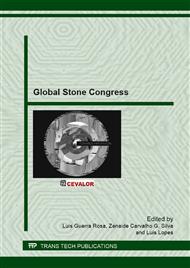p.31
p.39
p.48
p.57
p.65
p.72
p.82
p.90
p.98
Comparative Study between Coefficient of Dynamic Friction and Slab Surface Roughness of Brazilian Siliceous Dimension Stones
Abstract:
The sawing of granite blocks using multi-blade gangsaws and an abrasive mixture is one of the most complex operations in the transformation of commercial rocks. Many of the technological advances in sawing equipment have been accompanied by a mere handful of studies on the intrinsic properties of the rock that influence the sawing process. To optimize this process, it is vital to consider the rock as a “truly natural product”, keeping in mind that there is no quality control in its genesis. Thus, it is a material that has diversity in its characteristics and needs a technological control that considers, among other variables, the minerals’ relationships and ratios, namely: texture, structure and degree of microcracking and rock alteration. These peculiarities respond differently to the set of requests imposed during sawing, as for instance abrasion resistance and the impact of the blades in the gangsaw machines. This paper presents the study results on the quality of the sawing process developed by researchers at the Geotechnical Engineering Department of the São Carlos School of Engineering - São Paulo University. The surface quality of the finished slabs is the major determinant of the volume of material to be removed in subsequent polishing operations, thus influencing the final cost of the product. This quality was determined by using equipment capable of carrying out direct measurements of the roughness and coefficient of dynamic friction of the slab surface. The measurements carried out on three types of Brazilian siliceous dimension stone slabs showed differences in the sawing speed and industrial process costs. The roughness values obtained, together with the test results for the uniaxial compressive strength, Amsler wear, sawability, coefficient of dynamic friction and petrographic analysis, showed that the rock texture has the most important influence on the production cost of polished slabs.
Info:
Periodical:
Pages:
65-71
Citation:
Online since:
April 2013
Keywords:
Price:
Сopyright:
© 2013 Trans Tech Publications Ltd. All Rights Reserved
Share:
Citation:


